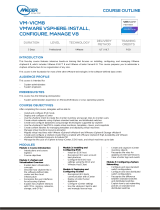
SaaS multi-cluster management features
The MyVxRail web portal provides access to SaaS multi-cluster management and analytics of your VxRail systems.
For each cluster, perform the following:
●Enable your Dell Technologies Support account.
●Configure Secure Remote Services.
●Opt into the Customer Improvement Program.
You can access the MyVxRail web portal from VxRail Manager.
Convert an internal VMware vCenter Server to an external VMware
vCenter Server
This is a one-way conversion from internal VMware vCenter Server to an external VMware vCenter. You cannot convert
an external-managed VMware vCenter Server to a VxRail-managed VMware vCenter Server. After converting to an external-
managed VMware vCenter server, the server and PSC life cycle are not managed by VxRail Manager.
Enable VMware vLCM (optional)
Use the VMware vSphere Client to enable VMware vSphere Lifecycle manager (vLCM). You cannot reverse VMware vLCM
once enabled. With VMware vLCM, the VxRail native LCM backend is not used for host upgrades in that cluster. If VMware
vLCM is enabled on VxRail clusters, you must manually upgrade the VMware vSAN disk format after the hosts are upgraded.
Update system software
Use SolVe Online for VxRail to generate the specific procedure to follow when updating your VxRail system software. You
can also install and use the SolVe Desktop application on your Windows system. Dell Technologies continually updates the
information in SolVe to ensure that the latest versions, procedures, and notes are available. Whenever you plan to perform
service of any kind on your VxRail environment, generate the SolVe procedure first to ensure that you have the latest content.
To upgrade from a release lower than 7.0.240, do not use VMware vLCM or VMware VUM to update components managed
by VxRail Manager. You may not be able to update your system software if your cluster is in an unhealthy state or has critical
health alarms. Open a service request, or contact your sales representative or reseller to arrange help in updating your system.
Configure VxRail satellite nodes
The VxRail Manager allows you to configure certain parameters that apply to the hosts in your VxRail cluster.
VxRail uses satellite nodes to provide simplicity, agility, and automation. Satellite nodes are used to address more edge use cases
with single node deployments. Satellite nodes extend VxRail operational model and efficiencies to edge sites while automating
day-to-day operations, health monitoring, and lifecycle management. This service is provided from a centralized location without
the need for local technical or specialized resources.
The satellite nodes are managed by a VxRail cluster with VMware vSAN that has been upgraded to 7.0.300, or later. Only
a VxRail cluster with an external VMware vCenter can manage satellite nodes. The VxRail Manager VM that is deployed can
control all satellite nodes from a centralized host management location in the VMware vCenter. Using VxRail Manager, you can
add, remove, and update satellite nodes from one access point.
The host folder is used to logically group the VxRail satellite nodes together.
From the VMware vSphere Client, you can perform the following:
●Configure iDRAC
●Add, edit, or remove a host folder
●Add a node to a folder
●Upgrade the folder
●Remove a host
Go to VxRail Manager for configuration steps that use the VMware vSphere Client. Go the VMware Docs for more information
about using the VMware vSphere Client.
12 VxRail Manager Overview





















